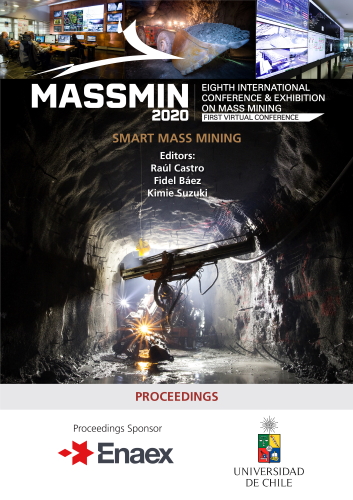Blasting design and drawbell implementation at the Chuquicamata Underground mine

|
Authors: Rodríguez, F; Berg, A; Videla, JC; Jamett, N; Morales, D; Castro, R; Arancibia, L |
This paper is hosted with the kind permission of Lulea University of Technology, International Conference & Exhibition on Mass Mining, 2024.
DOI https://doi.org/10.36487/ACG_repo/2063_64
Cite As:
Rodríguez, F, Berg, A, Videla, JC, Jamett, N, Morales, D, Castro, R & Arancibia, L 2020, 'Blasting design and drawbell implementation at the Chuquicamata Underground mine', in R Castro, F Báez & K Suzuki (eds), MassMin 2020: Proceedings of the Eighth International Conference & Exhibition on Mass Mining, University of Chile, Santiago, pp. 897-909, https://doi.org/10.36487/ACG_repo/2063_64
Abstract:
In caving operations, the blasting of drawbells is critical for starting production from drawpoints. The trend in the industry is to blast drawbells in a single phase to avoid exposing personnel to the front and to increase the rate at which drawpoints can be incorporated into production. A review of the current state of the art suggests there is no consensus on how to design a single-phase drawbell blast (SPDB). The Chuquicamata Underground Mine (MCHS) implemented an SPDB using emulsions as the explosive. Before implementation, trials were performed showing good results in relation to fragmentation and final drawbell geometry. The design was implemented at production scale allowing more than 8 drawbells to be incorporated per month. Based on the positive results, guidelines to blast drawbells in a single phase were established and are described in this article.
References:
Alcaíno, J, Morales, D & Paredes, P 2018, ‘Implementation of emulsion in horizontal developments’, PMCHS. UMINING 2018, II Ibero-American Congress in Underground Mining and Open Pit. Castro, R. and Herazo, Y. (eds). Santiago, Chile, 13-15 June 2018. pp. 438-451, in Spanish.
Altamirano, A 2014, ‘Design of blasting in one phase- application to the Continuous Mining Project, Andina Mine’, Master Thesis, University of Chile, Chile, in Spanish.
Araneda, O 2015, ‘Challenges and Opportunities in open pit to underground transition at the Chuquicamata Underground Mine Project’, Mine planning 2015 Conference, Keynote presentattion, Antofagasta, Chile, 8-10 July 2015.
Dunstan, G & Popa, L 2012, ‘Innovative Cave Establishment Practices at Ridgeways Deeps’, Proceedings of MassMin 2012, Sudbury, Ontario, Canada.
Enaex 2018a, ‘First Drawbell Test Blast 22 - MB_S02 - Drives 3 and 4’, PMCHS Codelco VP.
Enaex 2018b, ‘Tests of Blasting of Drawbell on 1 Phase. Operational Planning’, August 2018.
Jofre, J, Yañez, P, & Ferguson, G 2000, ‘Evolution in Panel Caving undercutting and drawbell excavation, El Teniente Mine’, in G Chitombo (ed.), Proceedings of MassMin 2000, Australian Institute of Mining and Metallurgy, Melbourne, Australia, pp. 249-260.
Lovitt, M & Degay, B Jr 2003, ‘Single shot drawbell blasting with Orica’s i-kon® detonators at Freeport. In Explosives and Blasting Technique’, CRC Press, pp. 240-247.
Music, A. & San Martin, J 2010, ‘Great volume Drawbells at El Teniente. Internal Report’, CODELCO, Division El Teniente.
Paredes, P, Rodríguez, F, Castro, R, Morales, D, García, D 2019, ‘Design and evaluation of one-phase drawbell excavation at the Chuquicamata Underground Mine’, Journal of the Southern African Institute of Mining and Metallurgy, vol. 119, no. 12, pp. 1061-1070.
Persson, P, Holmberg, R, Lee, J 1994, ‘Stress Waves in Rock, and Fragmentation’, In Rock blasting and explosive engineering, CRC, pp. 233-264.
Silveira, AC, Lovitt, M, & Hewitt, T 2005, ‘Off to a good start with Lift #2: Drawbell extraction – Norhparkes’, Proceedings Ninth Underground Operators’ Conference, Perth, Australia, 2005, The Australasian Institute of Mining and Metallurgy, pp. 75-80.
© Copyright 2025, Australian Centre for Geomechanics (ACG), The University of Western Australia. All rights reserved.
View copyright/legal information
Please direct any queries or error reports to repository-acg@uwa.edu.au
View copyright/legal information
Please direct any queries or error reports to repository-acg@uwa.edu.au
